The Impact of Environmental Regulations on Power Generation
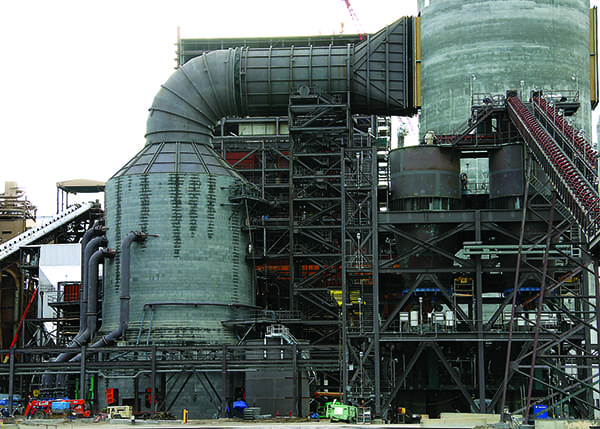
For many years, air pollution control (APC) rules and regulations have governed the design and economics of the world’s power generation fleet. These rules have had a tremendous impact, improving air quality even while the fleet’s capacity has increased significantly. They have also resulted in the development and deployment of many innovative APC technologies.
Environmental rules dating back 40 years or more have spawned new rules, which cover different operating parameters in power plants. For example, there have been several rules and regulations based on the Clean Air Act Amendment of 1990 that required coal-fired plants to install flue gas desulfurization (FGD) systems. Most of these FGD systems were of the wet design (see opening image), which resulted in a significant increase in synthetic gypsum being made available to the market. This created a profitable new commercial industry and made for more affordable housing. For example, a dedicated wall board plant was built in North Carolina specifically to handle the gypsum produced by Duke Energy’s FGD program.
However, in 2015 the U.S. Environmental Protection Agency (EPA) finalized a rule revising the regulations for the Steam Electric Power Generating Effluent Limitation Guidelines (ELGs), regulating mercury and other constituents (such as selenium, arsenic, and nitrates) in wastewater discharges from FGD systems. FGD systems are a technology that removes mercury from the flue gas of coal-fired plants, but the mercury and other constituents end up in the FGD wastewater, which is regulated under the ELG rule. The treatment requirements under these additional wastewater regulations add a significant cost to operations of wet-FGD systems. In addition, the EPA finalized the Coal Combustion Residuals (CCR) rule in 2015, which included changes to the specifications for gypsum storage.
When the original SO2 regulations were adopted, few people anticipated the boom in the synthetic gypsum market or the co-benefits that FGD would play in reducing mercury emissions. Furthermore, it was unknown what effect the ELG or CCR rules would have in the future.
Fractured Regulation Increases Costs
In the U.S., there is a fractured system of environmental laws. There is the Clean Air Act, the Clean Water Act, and the Resource Conservation and Recovery Act (RCRA), which covers the disposal of solid waste. Congress and the EPA, in their respective roles in regulations, tend to concentrate on a single issue, such as SO2 reduction, in a segmented manner. For example, they often regulate air emissions without considering the resulting long-term impact on water and solid waste issues. This piecemeal approach has resulted in many units closing before end-of-life due to the continuing, accumulating, and often speculative environmental costs of complying with each regulation in turn.
The costs for ongoing retrofitting for compliance and/or the stranded costs for early closure are frequently passed on to electricity consumers. For units that continue to operate, the regulations have significantly reduced profit margins as retrofitting and increased operations and maintenance (O&M) costs mount up. Additionally, the ambiguity in many of the regulations has led to a plethora of court cases, which have spread speculation throughout utilities that must question or re-evaluate compliance strategies.
In the European Union (EU), the current Industrial Emissions Directive (IED) is based on an integrated approach, which embraces the use of best available techniques and plant-specific permits for operation. These permits consider the whole environmental performance of plants, covering emissions to air, water, and land; generation of waste; use of raw materials; energy efficiency; noise; prevention of accidents; and restoration of sites upon closure.
Individual EU member states must transpose EU legislation into national legislation and, in doing so, must create legislation which is as stringent as, or more so than, the EU legislation. The broad nature of the IED gives national regulators and plant owners a comprehensive overview of the options for compliance. This approach allows utilities to estimate a holistic cost for the entire suite of control systems required and can significantly reduce costs when designing a system that can utilize newer, multi-pollutant systems, and which can address air, water, and solid waste issues simultaneously.
While U.S. environmental laws may be far from perfect, there has been a significant improvement to ambient air quality in compliant regions. Table 1 presents the overall reduction of NOx and SO2 emissions in relationship to tons of coal for the fleet of coal-fired Electric Generating Units (EGUs) in the U.S. The table also shows how the average national ambient air concentrations of these pollutants have been reduced during the same period for the coal-fired EGU fleet.
 |
|
Table 1. Emissions reductions. NOx and SO2 emissions from coal-fired electric generating units have been significantly reduced in the U.S. since 1980. Source: U.S. Environmental Protection Agency |
This article reviews a series of air pollution regulations for coal-fired power plants starting with the 1970 Clean Air Act (CAA) and progressing through current regulations. The analysis largely reflects the sequence in which these regulations or rules were promulgated.
Clean Air Act 1970
The CAA set emission limits for pollutants in a sequential manner over time, starting with particulate emissions.
Particulates. The EPA was established by the Nixon administration in December 1970. During the early 1970s, the EPA developed New Source Performance Standards (NSPS) for particulate emissions from coal-fired plants. The NSPS resulted in research and development to improve performance of electrostatic precipitators (ESPs). New ESP controls were developed and larger ESP designs evolved. In addition, new modeling techniques were developed to improve performance and mitigate malfunctions within these systems. The positive impacts included:
■ New markets were developed for the sale of ash, primarily in the cement and concrete industries. This developed into new revenue streams for utilities and minimized ash disposal.
■ Better and more reliable particulate control system performance.
Negative impacts included:
■ The requirement for lower emissions led to the development of an SO3 injection technology to enhance the performance of small ESPs. SO3 conditioning became a significant problem when the Mercury and Air Toxics Standards (MATS) rule came into effect, because SO3 interferes with the capture of mercury.
■ Ash that could not be sold had to be landfilled and ultimately became regulated under the CCR rule in 2015.
Nitrogen Oxides. In the 1970s, in response to new emission limits for NOx, the first generation of low-NO x coal burners were developed. Positive impacts included:
■ Low-NOx burners helped reduce NOx emissions from the combustion zone, and thus helped to reduce the amount of ammonia required in selective catalytic reduction (SCR) and selective non-catalytic reduction (SNCR) technologies, which were often required by later regulations as additional NOx control options.
■ The development of enhanced combustion controls in the 2000s helped to balance competing factors to simultaneously achieve NOx, CO, and unburned carbon in ash reductions.
Negative impacts also resulted, including:
■ The first generation of low-NOx burners caused excessive water wall wastage, resulting in lower plant availability and higher maintenance costs.
■ The burners, while lowering NOx, tended to increase CO emissions. Additionally, these burners tended to increase unburned carbon in fly ash, thus causing more ash to be less salable and more of it to be landfilled.
■ The installation of these burners and the higher CO emissions resulted in possible New Source Review (NSR) violations.
■ To control the combustion process and steam production, new burner controls were required, resulting in higher-than-anticipated costs due to increased boiler tube wastage as a consequence of deeper air staging in the boiler.
1977 and 1990 CAA Amendments
As the law evolved, major changes ensued in the power industry. The first was the requirement to reduce SO2 emissions, which required either the installation of FGD technology (Figure 1) or the switch to lower sulfur coals. The second issue was the initiation of NSR requirements, regulating modification to existing plants. The third change was the ability to increase enforcement via Title V permits.
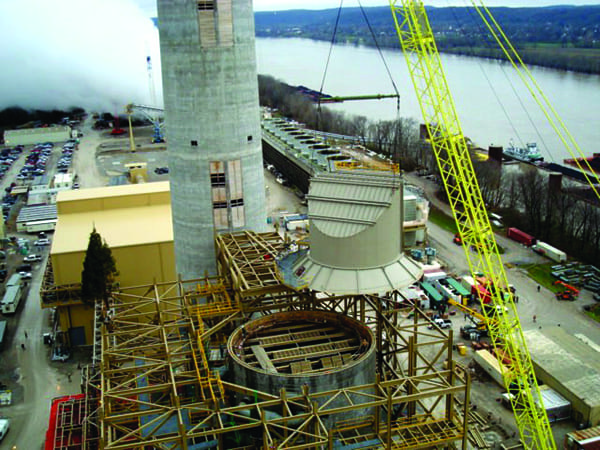 |
|
1. Flue gas desulfurization (FGD). All four units at the Ghent Generating Station are equipped with FGD systems following retrofits completed between May 2007 and May 2009. This image shows the FGD outlet turret being installed on Unit 4 at the site. Courtesy: Babcock Power |
The law provided options for plants to switch to lower sulfur fuels or install emission controls. The SO2 requirements led to the expansion of Power River Basin (PRB) coal mines in the western U.S. and the rail transportation system required to bring western coals to the east. Both, the switching of coal and the installation of FGDs, had negative and positive impacts that were not foreseen when the law was developed.
The development of SO2 FGD technology was just beginning at the time and there were many technology failures along with advancements. In the mid-1980s, new environmental rules in Germany required the installation of FGD systems on plants in that country, and some of the German technology developments were imported to the U.S. Some of the positive impacts included:
■ An industry developed to manufacture wall board from the gypsum by-product. This was an economic benefit to local communities and the housing industry. However, not all power plant gypsum production was in economically viable areas due to transportation costs, so some by-product had to be landfilled. Yet, other markets emerged, including for mining run-off mitigation and agricultural use.
■ FGD systems were beneficial in reducing mercury emissions and helped with MATS rule compliance.
Not all impacts were favorable. Some of the unforeseen negative effects included:
■ Wet FGD systems require a significant amount of electricity to operate, which results in an increase in a plant’s heat rate, decreasing efficiency by 2% to 3%.
■ Landfilling FGD by-product became regulated by the CCR rule.
■ Because FGD systems capture mercury in wastewater, the discharge became regulated under the ELG rule.
Fuel switching to PRB coal as a sulfur reduction strategy also had unforeseen impacts.
Some of the positive impacts included:
■ The ash from PRB coals became a desired product for the cement industry and became a revenue stream for utilities, which reduced landfilling obligations.
■ PRB coals have a higher moisture content and a lower fuel nitrogen content, resulting in lower NOx emissions than from eastern coals.
■ The availability of lower cost PRB coals also brought the cost of eastern coals down.
Negative impacts of fuel switching included:
■ SO2 emissions from PRB coal are lower than uncontrolled emissions from Eastern coals. Some plants burning PRB coal could meet legal emissions limits without FGD systems, but their emissions were still higher than the equivalent emissions that could have been achieved if FGD had been installed on units fired with Eastern coal. As a result, the U.S. experienced higher SO2 emissions than would have been obtained with FGD systems installed across the fleet.
■ The use of PRB coals can result in higher particulate matter (PM) emissions because the ash is captured less efficiently by ESP systems. SO3 conditioning systems can be installed to reduce the effect, but these can interfere with the capture efficiency of mercury.
■ The use of PRB coal resulted in higher CO2 emissions (on a lb/MWh basis) than when using Eastern coals.
■ When fuel switching began, existing boilers and combustion systems were not designed to burn PRB fuel. As a result, these boilers had to be de-rated due to a combination of mill capacity and slagging issues.
■ Firing PRB in boilers designed for Eastern coal resulted in excessive slagging and fouling, with corresponding decreases in availability, increases in O&M costs, and increases in emissions.
■ PRB fuels are typically lower in sulfur content and this results in much smaller quantities of gypsum being produced by FGD systems on PRB plants. In some cases, this can mean that gypsum production is not financially viable, with the by-product being landfilled instead. This means the loss of an additional revenue stream and potentially new disposal costs.
The enforcement of the NSR rule with respect to plant upgrades and modifications had several impacts. One positive environmental aspect was that SO2, NOx and PM controls were required earlier than would have been required by other regulations alone, at least in some cases.
Among the negative impacts was a delay by many owners in implementing air pollution control (APC) upgrades due to uncertainty over the interpretation of NSR requirements. Furthermore, many plant owners did not implement efficiency improvements during APC and boiler system retrofits, thus missing the opportunity to avoid higher CO2 emissions.
Updated NOx Requirements
In 1997, new ozone regulations required Eastern utilities to reduce their NOx emissions. The NOx Budget Trading Program operated from 2003 to 2008. During that time, NOx reductions could no longer be achieved with simply low-NOx burners, instead they required SCR (Figure 2) or SNCR technologies at many plants.
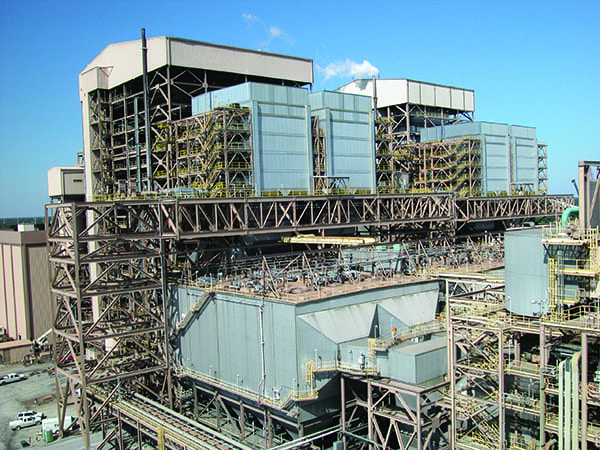 |
|
2. Selective catalytic reduction (SCR). All four units at the Winyah Generating Station are equipped with SCR systems (shown here) following retrofits completed in 2003 and 2004. Courtesy: Babcock Power |
SCR technology was originally developed in Japan, but it was fully implemented in Germany in the late 1980s. Most of the SCR installations in the U.S. were developed through technology transfer from Germany. Some significant issues were experienced at early U.S. installations because the coals used in Germany were different from those used in the U.S.—the technology could not be purely transferred from Japan and Germany, but instead required re-engineering for U.S. coal and utility operations.
One positive aspect this had on the U.S. market was, when firing Eastern bituminous coals, SCR oxidizes elemental mercury, which helps to reduce overall mercury emissions.
However, the negative impacts included:
■ Some of the initial SCR installations resulted in high ammonia levels in the fly ash, which affected ash sales, reducing revenue, and requiring landfilling and CCR compliance.
■ Operation of SCRs can result in increased emissions of SO3 and sulfuric acid mist, which creates “blue plumes” and results in a violation of the NSR requirements. This can also result in the plugging of air heaters, reducing plant performance and increasing O&M costs.
■ In units firing PRB coal, ammonia can have negative impacts on mercury capture.
■ Catalysts used in SCRs have a defined useful life and must be disposed of in accordance with RCRA.
The next major rule to be implemented was the Clean Air Interstate Rule (CAIR), regulating SO2 and NOx emissions from EGUs. The CAIR NOx ozone season and annual programs began in 2009, while the CAIR SO2 annual program began in 2010.
CAIR was abandoned due to legal issues and the EPA issued the Cross-State Air Pollution Rule as a replacement on July 7, 2011. Again, SO2 and NOx were the prime pollutants addressed. The technologies used for compliance within these rules were FGD and SCR; their impacts have already been discussed.
MATS Rule Cost Impacts
The last major air pollution rule to be promulgated by the EPA (other than the Clean Power Plan) was the MATS rule, which was published in December 2011. This rule addressed emission limits for mercury, heavy metals, and acid gases, specifically HCl and SO2. The rule also covered startup, shutdown, and maintenance procedures, but this aspect of the rule will not be covered in this article.
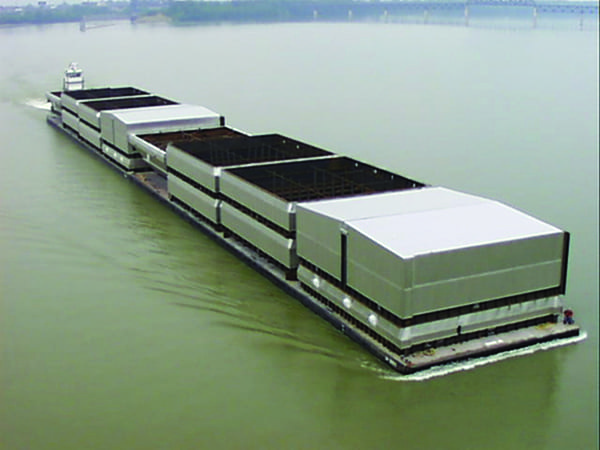 |
|
3. SCR modules. Air quality control system retrofits often involve the shipment of large components, such as the SCR modules shown here being delivered to an American Electric Power site by barge. Courtesy: Babcock Power |
The analysis of the impacts of the MATS rule is more complex than prior rules and regulations due to its multi-pollutant coverage and the resulting increase in the requirements and options for compliance—to comply with the MATS limits, more than one technology may be necessary. As a result, many control options were employed for MATS compliance, including the co-benefit effects of SCRs (Figure 3), baghouses, ESPs, and FGD systems (Figure 4), along with new multi-pollutant systems and mercury-specific control strategies.
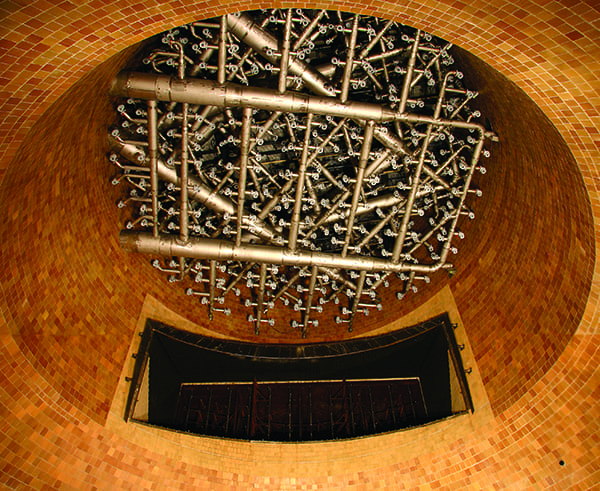 |
|
4. Spray headers. Wet FGD absorber vessels include multi-layered spray headers to facilitate the scrubbing process. Courtesy: Babcock Power |
The economic pressures of compliance with the MATS rule and the price of natural gas available for power generation have directly resulted in the closure of more than 30 GW of coal-fired capacity. As a result, there has been regional shortages of fly ash sold to the cement industry. This shortage has caused fly ash to be imported from China in some cases. However, certain high-uranium coal deposits in China produce fly ash that is too radioactive for reuse.
Mercury emissions are primarily controlled by either co-benefits or sorbents, such as activated carbon injection (ACI) or halogens, to capture mercury in existing APC systems (baghouses, ESPs, and FGD systems). Halogens can also be used to enhance mercury capture with other technologies. Other heavy metals are almost completely associated with particulate emissions and are therefore controlled via the application of ESPs or baghouse systems. HCl and SO2 can be controlled by dry sorbent injection (DSI) and PM controls, or FGD systems. The EPA provides an alternative for HCl control if a plant uses SO2 controls, resulting in the installation of some dry FGD systems. In certain applications, ACI, PM, and FGD are used in combination for MATS compliance.
Since numerous combinations of control technologies are being use for MATS compliance, the analysis of positive and negative impacts is broken down into four segments: ACI, halogen injection, dry FGD, and DSI. The following is a summary of the positive and negative impacts of these four technologies.
ACI Technology. Beyond mercury reduction, no other discernible positive impacts were observed from ACI. Among the negative impacts were:
■ ACI can have a negative impact on the sale of ash, resulting in higher compliance and disposal costs, as well as CCR and ELG compliance issues.
■ There has been a concern about the impact of ACI on ESP performance, which can require ESP upgrades or the installation of a baghouse. This means a choice between investment in PM control systems or potentially increased PM emissions. However, there have been several conflicting reports on the impact of ACI on ESP performance including reports of no impact.
■ If the fly ash from a plant goes to a landfill or pond, there are impacts to either CCR or ELG compliance and additional expenses.
Halogen Injection. Some plants in the U.S. use bromine compounds as an oxidant to enhance mercury capture. Much like ACI, no discernible positive impacts were observed from this beyond mercury reduction. However, the negative impacts include:
■ Corrosion has been reported in various parts of the boiler train and APC equipment, most commonly in air preheaters in boilers firing subbituminous coal.
■ There have been reports of interferences with mercury measurement when halogens are used.
■ The use of halogens is likely to impact compliance with future wastewater limits. High concentrations of bromide in FGD wastewater going to a biological reactor in a wastewater treatment system interfere with microbial activity. There has been concern in some states about the discharge of bromide from FGD systems into bodies of water that are upstream of drinking water treatment plants.
Dry FGD Technologies. One positive impact of a dry FGD is that a single system can be applied to control mercury, HCl, heavy metals, and PM. In some cases, though, ACI may have to be added. However, the markets for by-products from dry FGD systems is very limited; therefore, most by-products must be landfilled while complying with CCR requirements, which can be costly. Another negative impact is that dry FGD systems have a high electric power requirement, which impacts a plant’s heat rate and results in increased CO2 emissions.
DSI Technology. Most common applications in the U.S. involving DSI include various sodium-based sorbents, such as trona or sodium bicarbonate, and various hydrated-lime products. Both lime and trona have different impacts on performance and economics. Among the positive impacts are:
■ When trona or sodium bicarbonate are used as the sorbent, ESP performance may improve.
■ DSI can enhance mercury control (by reducing SO3 concentrations in the flue gas) while reducing acid gases.
■ DSI can be used to reduce air heater fouling.
The negative impacts, however, include:
■ DSI can impact ash sales resulting in loss of revenue and potential new landfilling costs.
■ When sodium-based sorbents are use, they can impact the ability to landfill ash due to leaching of heavy metals.
■ ESP performance may decline when lime-based sorbents are used and may result in slightly higher PM emissions.
■ When sodium-based sorbents are used at high dosing rates, higher NO2 emissions can occur, resulting in a visible stack plume, and in extreme situations, potential NSR violations.
■ When sodium-based sorbents are used to control acid gases while activated carbon is used to control Hg, the formation of NO2 can negatively impact the efficiency of Hg removal by the activated carbon.
One Size Does Not Fit All
There have been numerous APC rules and regulations that have been implemented in the U.S. since the adoption of the first CAA. None of these rules have been integrated environmental rules that consider air, water, and solid waste simultaneously. This has led to a complex structure of rules and regulations that sometimes conflict, and can impact compliance and economics.
In some situations, the adoption of effective emission control strategies during the 1980s had the benefit of ensuring continued compliance when further legislation tightened requirements. However, in other cases, alternative compliance strategies, such as fuel switching or emissions trading, simply delayed solutions and meant that APC systems were eventually compulsory. This has meant continuing compliance issues and delayed retrofitting costs for some plants.
With hindsight, many plant operators would have made very different technology choices had they been able to predict the evolution of emissions legislation since the 1980s. In some ways, the more prescriptive and broader nature of legislation in the EU (encompassing air, water, and waste simultaneously) has meant that coal-fired plants in Europe have not had to go through as many dramatic shifts in control strategies as those in the U.S.
Owners who complied with rules adopted in the 1980s have found that it occasionally resulted in additional compliance with different rules 20 years later. If decisions could have been made with future ELG rules in mind, there likely would have been more dry-FGD system retrofits than ultimately resulted. While it is more difficult to retrofit dry FGD technology, it eliminates most of the ELG concerns.
In the future, regulators should look deeper into the impact that regulations have on technologies and economics. Lessons can be learned from the piecemeal evolution of legislation over time, as well as from contrasting approaches to legislation and control used in other regions of the world.
That said, what works in one region does not necessarily translate elsewhere. For example, just because SCRs work on German coals does not mean that they will work equally well on U.S. coals without major design and operating changes. Conversely, the strategies being used to reduce mercury emissions under MATS are not guaranteed to work on German lignite units. ■
—Anthony Licata is a partner with Licata Energy. He has more than 40 years of extensive experience in the power generation field. Input for this article was also received from Dr. Lesley Sloss of the International Energy Agency’s Clean Coal Centre; Dr. Connie Senior, executive editor-in-chief with Clean Energy; Block Andrews, retired Burns & McDonnell environmental expert; Grant Grothen of Burns & McDonnell; Michael Goo of AJW; Ed Healy of Southern Company; and Dr. Jim Staudt of Andover Technology Partners.